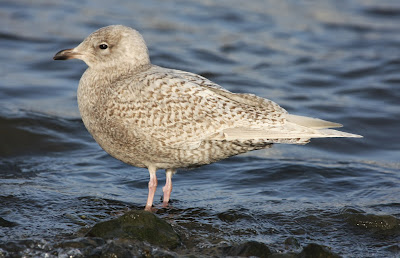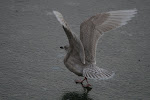At the time, the really really stood out as dark individual, but with no shadowing on the tail or primaries, I had quite a lot of trouble turning it into anything other than a glaucoides Iceland Gull.
Recently, I came across 'The Hampton Scale'. A plumage scoring system to effectively categorise any Iceland, Kumlien's or Thayer's Gull to a proper name.
The scale looks at the Outer Primaries, Secondaries, Tertials, Tail, Scapulars/Coverts, Bill Colour, Head and Bill structure and shape.
Outer Primaries - Under the scoring system, this bird scores 2 for the outer primaries with obvious dark 'arrows' that are quite dark, but there is pretty much no hint of dusky tipping to the outer primaries like scores 3-5 show.
Secondaries - This is an interesting one as the secondaries do show somewhat of a bar and the score, for me, is somewhere in the middle of 2 and 3. This is because the score for 2 is the same colour as the coverts and 3 is quite obviously dusky in comparison. This bird has a bar just a touch darker than the coverts in flight. I feel I will round down and give this a 2 for the benefit of the not jumping to conclusions!
Tertials - There's no denying that these tertials certainly aren't white. For a 'white-winger' these are pretty heavily marked and are awarded a 2. They certainly do not fall into the third category as there is no smoky basal tone to the centre of the feather as with other large white-headed gulls.
Tail - Now this is a bit more of a tricky one as it varies slightly in different light and the scale isn't that clear cut. As far as I'm aware, this is quite a dusky tail with an almost dark tail band. This easily scores 2, again (there's a theme forming here!) with heavy barring, but certainly no real sign of a smoky basal tone. As far as I'm aware, a bar on the tail is certainly a pro-Kumlien's Gull feature regardless of the scale's validity.
Coverts and Scapulars - I think one of the main causes of this bird appearing so dark is due to the density of barring on coverts and scapulars. This bird scores...you've guessed it! TWO! I think it's even more densely barred than the example photo on the scale website, but I certainly don't think it's dark enough for a 3.
Bill colour - It's supposed that the darker the bill, the closer it is to Thayer's and the more two-toned it is, the more Iceland it is. This bird has a relatively dark bill and the three photos I have presented here show it is very strong light and therefore the pale stands out a lot. I think this bird scores 1 on the colour scale and 2 just seems a little too dark
Head and Bill shape - whereas the previous features have been relatively easy to score based on them being pretty much the same no matter what light or angle the bird is, in structure, very subjective indeed and especially with the head, is incredibly variable. I certainly don't think this is as round and delicate headed the describe '0' Iceland Gull. I think the snoutyness and crowned appearance is quite pronounced in this bird, but the bill does appear quite delicate with only a slight gonydeal angle. As a result, I think this bird scores a 2, (an average based on that I could be tempted to score 1 for the bill and 3 for the head).
So what are the scores on the doors? 13. Well that's all good an well, but what does this mean? You can't just go around and say 'oo I've got a 13 Iceland Gull!' as people will think you're a crazy person.
Investigations into other peoples ideas of where to draw the line from the author said that:
So it's a Kumlien's right? Well I'm not sure it's quite that simple really. This scale is designed to be able to categorise the birds we are all seeing in the North Atlantic to enable us to speak the 'same language' when describing the birds we are seeing.
It is ofcourse not as simple as this, otherwise we'd all be able to decide what on earth a Thayer's Gull is. The above image is a comparison photo of a dark Iceland (left) and pale (worn?) Kumlien's (right). One of the ways that the above images differ to 'species' level is the direction of dark markings in the primaries. Iceland Gulls appear to get paler inner primaries to the outers whereas Kumlien's are the opposite.
While the above Iceland is very dark, the outer 2-3 primaries certainly are very white indeed, especially compared to the primary coverts.
Now I'm not claiming my bird as anything. To be honest I'm not sure what it is and with the chance of Kumlien's being either a hybrid of Thayer's x Iceland, or a race of Iceland, or even a darker form of Iceland showing clinal change over their geographic range.
I will end this with another bird that was present at Preston Docks in the winter of 2010/2011. I believe this bird scores 7, so even this wonderfully white winged Iceland Gull could fit into the lower end of kumlieni in Newfoundland, but every other authority would class this as pretty conclusively Iceland.
Even if I've not proved anything conclusive, I've hopefully made your day a little brighter through these gorgeous birds!
Thank you for reading.







.jpg)






No comments:
Post a Comment